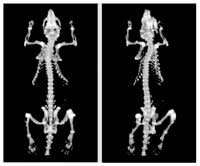Body Scanners for Lab Animals

This MicroPET scan of a live rat shows the skeleton.
A PET (positron emission tomography) scanner sensitive enough to use on laboratory mice has been developed by biomedical engineers at UC Davis. The device is already being used for studies on prostate cancer.
“We think it’s the highest resolution scanner in existence. We can see things we couldn’t see before,” said Simon Cherry, professor of biomedical engineering at UC Davis, who leads the research group.
PET scanners have become widely used in medical imaging, alongside X-rays, CAT scans and magnetic resonance imaging, because they can give information about metabolic activity in body tissues. The machines used for scanning people cannot see sufficiently fine detail for use on small animals such as mice and rats.
The current machine, called MicroPET II, can resolve a volume of about one cubic millimeter, or one microliter, Cherry said. That represents an approximately eight-fold improvement over an earlier device built by Cherry’s laboratory at UCLA, before moving to UC Davis in 2001.
PET works by detecting short-lived radioactive tracers that emit positrons, or anti-electrons. Those tracers can be attached to other molecules that are targeted to particular cells. For example, highly active cells, such as cancer cells, can be tagged with radioactive glucose.
Non-invasive imaging technology such as PET allows researchers to gain more information and to use fewer animals in experimental studies. For example, researchers could use an experimental drug to treat cancer in mice and see if the tumors were shrinking. Without methods such as PET, small deposits of cancer cells are hard to detect in experimental animals.
Cherry presented the work at the annual meeting of the Society for Molecular Imaging in San Francisco, Aug. 15-18. The work has also been published in the journal Physics in Medicine and Biology.
Media contact(s):
Andy Fell, UC Davis News Service, (530) 752-4533, ahfell@ucdavis.edu
Media Contact
More Information:
http://www.news.ucdavis.edu/search/news_detail.lasso?id=6630All latest news from the category: Life Sciences and Chemistry
Articles and reports from the Life Sciences and chemistry area deal with applied and basic research into modern biology, chemistry and human medicine.
Valuable information can be found on a range of life sciences fields including bacteriology, biochemistry, bionics, bioinformatics, biophysics, biotechnology, genetics, geobotany, human biology, marine biology, microbiology, molecular biology, cellular biology, zoology, bioinorganic chemistry, microchemistry and environmental chemistry.
Newest articles

Nerve cells of blind mice retain their visual function
Nerve cells in the retina were analysed at TU Wien (Vienna) using microelectrodes. They show astonishingly stable behavior – good news for retina implants. The retina is often referred to…

State-wide center for quantum science
Karlsruhe Institute of Technology joins IQST as a new partner. The mission of IQST is to further our understanding of nature and develop innovative technologies based on quantum science by…

Newly designed nanomaterial
…shows promise as antimicrobial agent. Rice scientists develop nanocrystals that kill bacteria under visible light. Newly developed halide perovskite nanocrystals (HPNCs) show potential as antimicrobial agents that are stable, effective…



